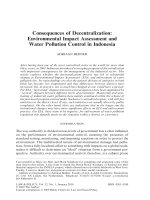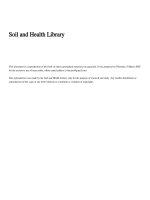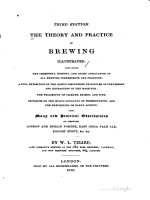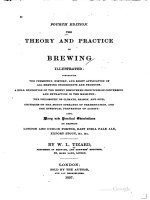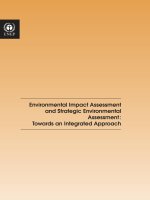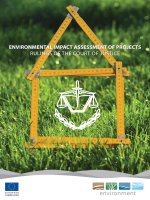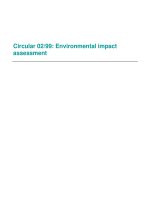Syllabus: Environmental impact assessment
Bạn đang xem bản rút gọn của tài liệu. Xem và tải ngay bản đầy đủ của tài liệu tại đây (202.48 KB, 6 trang )
THAI NGUYEN UNIVERSITY OF AGRICULTURE AND FORESTRY
INTERNATIONAL PROGRAM OFFICE
ESP179
ENVIRONMENTAL IMPACT ASSESSMENT
Syllabus
Picture best relevant to the subject
1
Teaching Staff
Subject lecturer: Ho Ngoc Son
Organization: Thai Nguyen University of Agriculture and Forestry
Office Location: Thai Nguyen University of Agriculture and Forestry
Phone: 02803851427
Mobile phone: 0976 501 716
Email:
Consultation hours: 13:30-15:00 Monday and Thursday
Dr Ho Ngoc Son got his PhD in Global Environment Change at the Australian National
University. Dr Son is senior lecturer and researcher of Thai Nguyen University of Agriculture
and Forestry. Dr Son teaches some courses such as biodiversity, climate change and
environmental impact assessment for both undergraduate and graduate students. Dr Son is
also a deputy Director of the Agriculture and Forestry Research & Development Centre for
Mountainous Region (ADC). ADC is implementing many research and development projects
in partnership with international and local non-governmental organisations.
Subject Overview
The Module is designed to provide a critical overview of the theory and practice of EIA as
operated internationally to those students who need to understand EIA: this includes formal
students being graduate and postgraduate students, plus practitioners/professionals.
Within this framework there are opportunities to customise the material to reflect local
jurisdictional procedures and issues.
The Module covers the:
purpose and aims of EIA;
EIA administration and practice;
concept of associated assessment processes;
key elements of the EIA process;
undertaking an EIA;
role of public participation;
stages that follow EIA;
the costs and benefits of undertaking EIA; and
understanding of the strengths and limitations of EIA.
Learning Outcomes
2
The aim of the course is to provide understanding of EIA. Broadly the objectives are for
students to:
+ appreciate the purpose and role of EIA in the decision-making process;
+ understand the strengths of EIA in regard to environmental management;
+ understand the screening process;
+ understand the scoping process and how it is applied;
+ know the options for estimating environmental and social impacts;
+ know the format of an EIA Report
Subject Structure
Students are expected to attend 11 lectures.
The Subject’s timetable is as follows:
Lecture time and location:
Time: 13:10-16:00 Tuesday
Lecture hall: D304
List of lectures
Week
Time
Topic
Week 1
DD/MM/YY
Overview of EIA
Week 2
DD/MM/YY
EIA introduction
Week 3
DD/MM/YY
EIA process
Week 4
DD/MM/YY
Social assessment and public participation
Week 5
DD/MM/YY
EIA methods and tools
Week 6
DD/MM/YY
Ecological risk assessment
Week 7
DD/MM/YY
Environmental monitoring
Week 8
DD/MM/YY
EIA communication
Week 9
DD/MM/YY
Writing an EIA report
Week 10
DD/MM/YY
Cumulative effect assessment (CEA)
Week 11
DD/MM/YY
Strategic environmental assessment
Instructional methods
(lecture, field trip,
discussion, etc.)
Lecture and discussion
Group 1 presentation,
lecture and discussion
Group 2 presentation,
lecture and discussion
Group 3 presentation,
lecture and discussion
Group 4 presentation,
lecture and discussion
Group 5 presentation,
lecture and discussion
Group 6 presentation,
lecture and discussion
Group 7 presentation,
lecture and discussion
Group 8 presentation,
lecture and discussion
Group 9 presentation,
lecture and discussion
Group 10 presentation,
lecture and discussion
3
Reading materials:
1. Alan Gilpin, 1995. Environmental impact assessment: Cutting the edge for twenty-first
century. Cambridge University Press.
2. Barbara Carroll and Trevor Turpin, 2009. Environmental impact assessment handbook: A
practical guide for planners, developers and communities. Thomas Telord.
3. Betty Bowers Marriott, 1997. Practical Guide to Environmental impact assessment.
McGraw-Hill.
4. Federal Environmental Assessment Review Office (1973). Ecological land survey
guidelines for environmental impact analysis
Attendance/ Participation Requirements
Lecture Attendance Requirement:
Attendance at all lectures is expected. If, for whatever reason, you cannot attend the lecture,
please let the lecturer know in advance. You are required to attend a minimum of 75% of
lectures.
Assessment
Assessment for this subject consists of :
Assessment type
Percentage
Participation
20
Group presentation
30
EIA report
50
Due Date
Assessment Criteria:
+ Participation will be assessed based on students’ active participation during the lectures
(asking questions, interaction, and attendance)
+ Group presentation will be assessed based on group and individual performance in their
presentation on given topics. Performance indicators such as preparation, innovation,
communication, responses to questions will be used.
+ EIA report will be assessed using standards of an EIA report such as following required
format, structure, writing quality, logic, reference.
4
Grading system
Grade
in letter
A
1-4
scale
4
1-10
scale
8.5 – 10
B
3
7 – 8.49
C
2
5.5 –
6.99
D
1
4 – 5.49
F
0
1-3.99
Description
Excellent
analysis,
comprehensive
research,
sophisticated
theoretical
or
methodological
understanding, impeccable presentation;
Work that meets all the key assessment criteria and
excels in most;
Work that meets these criteria and is also in some way
original, exciting or challenging could be awarded
marks in the high 8 or above.
Marks of 9 and above may be awarded to the best
student work in the range.
Good work that is solidly researched, shows a good
understanding of key ideas, demonstrates some use of
critical analysis along with good presentation and
documentation;
Work that meets most of the key assessment criteria
and performs well in some;
Work that shows some room for improvement.
Completion of key tasks at a satisfactory level, with
demonstrated understanding of key ideas and some
analytical skills, and satisfactory presentation,
research and documentation;
Work that meets most of the key assessment criteria;
Work that shows room for improvement in several
areas.
Completion of key tasks at an adequate level of
performance in argumentation, documentation and
expression;
Work that meets a limited number of the key
assessment criteria;
Work that shows substantial room for improvement in
many areas.
Work that fails to meet the basic assessment criteria;
Work that contravenes the policies and regulations set
out for the assessment exercise;
Where a student fails a subject, all failed components
of assessment are double marked.
Extension Policy and Late Submission of Work
Late work is not accepted. If, however, you find that it is absolutely impossible for you to
make a given deadline due to illness or other unforeseen circumstances, you may negotiate a
short-term extension of up to 5 working days. But please note: Extensions are not granted
after due dates have passed.
5
Penalty for Submission of Late Assessment
Assessment submitted late without an approved extension will be penalised at 2% per
working day. In-class tasks missed without approval will not be marked and in-semester tests
and exams that are submitted late without an approved extension will not be accepted.
Plagiarism
Plagiarism is academic misconduct, and is taken very seriously by the Program and
University. Any acts of suspected plagiarism detected by assessors will be followed up, and
any students involved will be required to respond via the Program and/or University
procedures for handling suspected plagiarism. If you have questions about how to
appropriately acknowledge your sources, please let the lecturer know.
International Program Office
Signature
Lecturer
Signature
Dr. Duong Van Thao
Dr. Ho Ngoc Son
6


